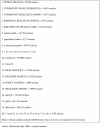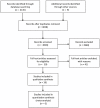The use of research evidence in public health decision making processes: systematic review
- PMID: 21818262
- PMCID: PMC3144216
- DOI: 10.1371/journal.pone.0021704
The use of research evidence in public health decision making processes: systematic review
Abstract
Background: The use of research evidence to underpin public health policy is strongly promoted. However, its implementation has not been straightforward. The objectives of this systematic review were to synthesise empirical evidence on the use of research evidence by public health decision makers in settings with universal health care systems.
Methods: To locate eligible studies, 13 bibliographic databases were screened, organisational websites were scanned, key informants were contacted and bibliographies of included studies were scrutinised. Two reviewers independently assessed studies for inclusion, extracted data and assessed methodological quality. Data were synthesised as a narrative review.
Findings: 18 studies were included: 15 qualitative studies, and three surveys. Their methodological quality was mixed. They were set in a range of country and decision making settings. Study participants included 1063 public health decision makers, 72 researchers, and 174 with overlapping roles. Decision making processes varied widely between settings, and were viewed differently by key players. A range of research evidence was accessed. However, there was no reliable evidence on the extent of its use. Its impact was often indirect, competing with other influences. Barriers to the use of research evidence included: decision makers' perceptions of research evidence; the gulf between researchers and decision makers; the culture of decision making; competing influences on decision making; and practical constraints. Suggested (but largely untested) ways of overcoming these barriers included: research targeted at the needs of decision makers; research clearly highlighting key messages; and capacity building. There was little evidence on the role of research evidence in decision making to reduce inequalities.
Conclusions: To more effectively implement research informed public health policy, action is required by decision makers and researchers to address the barriers identified in this systematic review. There is an urgent need for evidence to support the use of research evidence to inform public health decision making to reduce inequalities.
Conflict of interest statement
Figures
References
-
- Kemm J. The limitations of ‘evidence-based’ public health. J Eval Clin Pract. 2006;12(3):319–24. - PubMed
-
- Hunter DJ. Relationship between evidence and policy: A case of evidence-based policy or policy-based evidence? Public Health. 2009;123:583–586. - PubMed
-
- Killoran A, Kelly M. Towards an evidence-based approach to tackling health inequalities: the English experience. Health Education Journal. 2004;63(1):7–14.
Publication types
MeSH terms
Grants and funding
LinkOut - more resources
Full Text Sources



